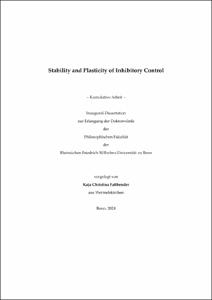Faßbender, Kaja Christina: Stability and Plasticity of Inhibitory Control. - Bonn, 2024. - Dissertation, Rheinische Friedrich-Wilhelms-Universität Bonn.
Online-Ausgabe in bonndoc: https://nbn-resolving.org/urn:nbn:de:hbz:5-73995
Online-Ausgabe in bonndoc: https://nbn-resolving.org/urn:nbn:de:hbz:5-73995
@phdthesis{handle:20.500.11811/11244,
urn: https://nbn-resolving.org/urn:nbn:de:hbz:5-73995,
doi: https://doi.org/10.48565/bonndoc-201,
author = {{Kaja Christina Faßbender}},
title = {Stability and Plasticity of Inhibitory Control},
school = {Rheinische Friedrich-Wilhelms-Universität Bonn},
year = 2024,
month = jan,
note = {Throughout life and in various situations, people are required to control their behaviour, suppress automatic responses, resist distraction, and selectively direct their attention. However, they are not always equally successful. Thus, an important question that has not been addressed sufficiently is to what extent behavioural inhibitory control is determined by stable traits or time-varying states. Furthermore, how can inhibitory control be influenced deliberately, and what processes underlie this ability? In particular, the influence of inhibitory neurotransmitters on inhibitory control is mostly unknown, and it has not yet been clarified whether inhibitory control is a unitary construct at all or comprises multiple unrelated subcomponents. This thesis aims to address these research gaps regarding the stability and plasticity of inhibitory control.
To this end, results from four studies are presented. In all studies, data from healthy adult students were assessed, and within-subject designs with measurement occasions at one-week intervals were applied. Data analyses include latent state-trait modelling (Study 1) and distributional analyses such as delta plots (Study 2, 4) and Stochastic Early Reaction, Inhibition, and late Action (SERIA) models (Study 3).
In Study 1, data from different inhibitory control tasks (antisaccade, Eriksen flanker, go-/no-go, Simon, stop-signal and Stroop tasks) were decomposed into stable traits and time-varying states. While performance in individual tasks was found to be mainly influenced by traits, those task-specific traits were mostly unrelated. Task-specific results were also evident in the pharmacological studies (Studies 2 – 4). In Study 2, the effect of lorazepam administration on antisaccade, Eriksen flanker, and Simon tasks was investigated. Lorazepam increases the neural activity of the major inhibitory neurotransmitter γ-aminobutyric acid (GABA). The results clearly suggest a role of inhibitory neurotransmitters in inhibitory control. To better understand task-specific results, data from the antisaccade and Simon tasks were further analysed using SERIA models that distinguish between automatic and controlled responses (Study 3) and lorazepam effects in the Eriksen flanker task were examined more closely in Study 4. Therefore, the task was slightly modified while keeping the study design similar to Study 2. The results from Studies 3 and 4 indicate that increased inhibitory neurotransmitter activity may impair suppressing automatic responses and widen the focus of selective attention, causing distractors to interfere more strongly.
In conclusion, the results reported here suggest that inhibitory control tasks are determined mainly by stable – yet task-specific – traits and that inhibitory control is worsened by increased neural inhibition.},
url = {https://hdl.handle.net/20.500.11811/11244}
}
urn: https://nbn-resolving.org/urn:nbn:de:hbz:5-73995,
doi: https://doi.org/10.48565/bonndoc-201,
author = {{Kaja Christina Faßbender}},
title = {Stability and Plasticity of Inhibitory Control},
school = {Rheinische Friedrich-Wilhelms-Universität Bonn},
year = 2024,
month = jan,
note = {Throughout life and in various situations, people are required to control their behaviour, suppress automatic responses, resist distraction, and selectively direct their attention. However, they are not always equally successful. Thus, an important question that has not been addressed sufficiently is to what extent behavioural inhibitory control is determined by stable traits or time-varying states. Furthermore, how can inhibitory control be influenced deliberately, and what processes underlie this ability? In particular, the influence of inhibitory neurotransmitters on inhibitory control is mostly unknown, and it has not yet been clarified whether inhibitory control is a unitary construct at all or comprises multiple unrelated subcomponents. This thesis aims to address these research gaps regarding the stability and plasticity of inhibitory control.
To this end, results from four studies are presented. In all studies, data from healthy adult students were assessed, and within-subject designs with measurement occasions at one-week intervals were applied. Data analyses include latent state-trait modelling (Study 1) and distributional analyses such as delta plots (Study 2, 4) and Stochastic Early Reaction, Inhibition, and late Action (SERIA) models (Study 3).
In Study 1, data from different inhibitory control tasks (antisaccade, Eriksen flanker, go-/no-go, Simon, stop-signal and Stroop tasks) were decomposed into stable traits and time-varying states. While performance in individual tasks was found to be mainly influenced by traits, those task-specific traits were mostly unrelated. Task-specific results were also evident in the pharmacological studies (Studies 2 – 4). In Study 2, the effect of lorazepam administration on antisaccade, Eriksen flanker, and Simon tasks was investigated. Lorazepam increases the neural activity of the major inhibitory neurotransmitter γ-aminobutyric acid (GABA). The results clearly suggest a role of inhibitory neurotransmitters in inhibitory control. To better understand task-specific results, data from the antisaccade and Simon tasks were further analysed using SERIA models that distinguish between automatic and controlled responses (Study 3) and lorazepam effects in the Eriksen flanker task were examined more closely in Study 4. Therefore, the task was slightly modified while keeping the study design similar to Study 2. The results from Studies 3 and 4 indicate that increased inhibitory neurotransmitter activity may impair suppressing automatic responses and widen the focus of selective attention, causing distractors to interfere more strongly.
In conclusion, the results reported here suggest that inhibitory control tasks are determined mainly by stable – yet task-specific – traits and that inhibitory control is worsened by increased neural inhibition.},
url = {https://hdl.handle.net/20.500.11811/11244}
}






